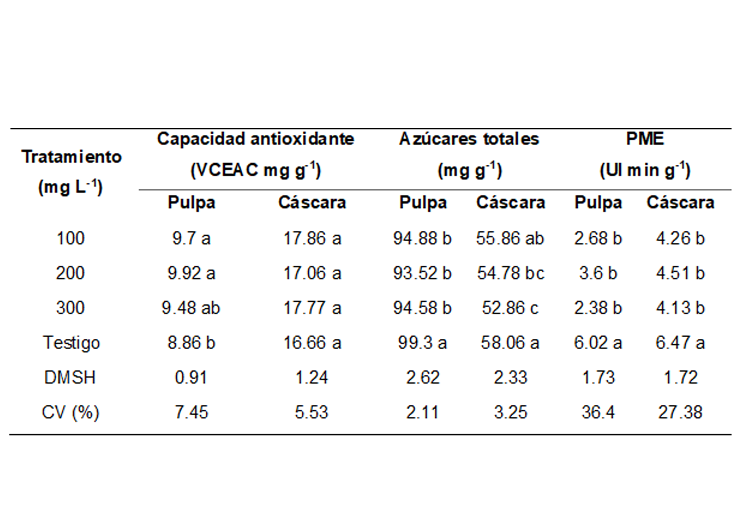Effect of ammonium molybdate on the quality of feijoa fruits
DOI:
https://doi.org/10.29312/remexca.v16i4.3695Keywords:
Acca sellowiana, bioactive compounds, plant nutritionAbstract
Molybdenum is an essential micronutrient that is involved in several enzymes, including nitrate reductase. This trial aimed to evaluate the physicochemical quality and the pectin methylesterase activity in fruits from feijoa trees sprayed with 0, 100, 200, and 300 mg L-1 of ammonium molybdate. To this end, an experiment was set up in 2023 in a completely randomized block design with three replications. Spraying 200 mg L-1 of ammonium molybdate increased the weight and firmness of the fruits. It was found that the pulp and skin of fruits harvested from trees treated with 100 mg L-1 showed lower vitamin C content, with values of 0.33 and 0.55 mg g-1, respectively. The application of molybdenum increased the content of total phenols in the pulp, with values that fluctuated between 3.72 and 3.66 mg g-1. Nonetheless, only the doses of 100 and 200 mg L-1 affected the values for this secondary metabolite in the skin. Only an increase in antioxidant capacity was observed for the pulp, where the dose of 300 mg L-1 was similar to the control. The pulp and skin of the fruits evaluated decreased their total sugar content and the levels of pectin methylesterase activity. Molybdenum foliar spraying can be a viable alternative to improve the size, firmness, and phenol content in the fruit pulp, parameters widely valued in harvest quality and during postharvest handling and that give high nutritional value to feijoa fruit.
Downloads
References
Do Amarante, C. V. T.; Souza, A. G.; Toè-Benincá, T. D. and Steffens, C. A. 2017. Phenolic content and antioxidant activity of fruit of Brazilian genotypes of feijoa. Pesqui. Agropecu. Bras. 52(12):1223-1230. Doi.org/10.1590/S0100-204X2017001200011.
Fischer, G.; Parra-Coronado, A. and Balaguera-López, H. E. 2020. Aspects of crop and physiology of feijoa (Acca sellowiana [Berg] Burret). A review. Ciencia y Agricultura. 17(3):11-24. https://doi.org/10.19053/01228420.v17.n3.2020.11386.
González-García, K. E.; Guerra-Ramírez, D.; Ángel-Coronel, O. A. and Cruz-Castillo, J. G. 2018. Physical and chemical attributes of feijoa fruit in Veracruz, México. Revista Chapingo Serie Horticultura. 24(1):5-12. Doi.org/10.5154/r.rchsh.2017.01.006.
Hagerman, A. E. and Austin, P. J. 1986. Continuous spectrophotometric assay for plant pectin methylesterase. J. Agric. Food Chem. 34(3):440-444. Doi.org/10.1021/jf00069a015.
Jagota, S. K. and Dani, H. M. 1982. A new colorimetric technique for the estimation of vitamin C using Folin phenol reagent. Anal. Biochem. 127(1):178-182. Doi.org/10.1016/0003-2697(82)90162-2.
Karsli, B. 2020. Antibacterial and antioxidant activity of pulp, peel and leaves of Feijoa sellowiana: effect of extraction techniques, solvents and concentration. Food and health. 7(1):21-30. Doi.org/10.3153/FH21003.
Lopes-Oliveira, S.; Costa-Crusciol, C. A.; Alves-Rodrigues, V.; Mayara-Galeriani, T.; Portugal, J. R.; Bossolani, J. W.; Moretti, L. G.; Calonego, J. C. and Cantarella, H. 2022. Molybdenum foliar fertilization improves photosynthetic metabolism and grain yields of field-grown soybean and maize. Front. Plant Sci. 13(887682):1-12. https://doi.org/10.3389/fpls.2022.887682.
Muñoz-Márquez, E.; Soto-Parra, J. M.; Pérez-Leal, R.; Yánez-Mosqueda, L. C. and Sánchez-Chávez, E. 2022. Application of nanomolybdenum in beans and its impact on nitrogen efficiency. Revista Mexicana de Ciencias Agrícolas. 13(28):319-329. Doi.org/10.29312/remexca.v13i28.3286.
Özgen, M.; Reese, R. N.; Tulio, A. Z.; Miller, A. R. and Scheerens, J. C. 2006. Modified 2,2-Azino-bis-3-ethylbenzothiazoline-6-sulfonic acid (ABTS) method to measure antioxidant capacity of selected small fruits and comparison to ferric reducing antioxidant power (FRAP) and 2,2’-diphenyl-1- picrylhydrazyl (DPPH). methods. J. Agric. Food Chem. 54(4):1151-1157. Doi.org/10.1021/jf051960d.
Phan-Thi, A. D. T.; Chaliha, M.; Sultanbawa, Y. and Netzel, M. E. 2019. Nutritional characteristics and antimicrobial activity of Australian grown feijoa (Acca sellowiana). Foods. 8(9):376-390. Doi.org/10.3390/foods8090376.
Sabatino, L.; D’Anna, F.; Iapichino, G.; Moncada, A.; D’Anna, E. and De Pasquale, C. 2019. Interactive effects of genotype and molybdenum supply on yield and overall fruit quality of tomato. Front. Plant Sci. 9(1922):1-10. https://doi.org/10.3389/fpls.2018.01922.
Waterman, P. G. and Mole, S. 1994. Methods in ecology. Analysis of phenolic plant metabolites. Blackwell Scientific publications. Oxford. 73-99 pp.
Witham, F. H.; Blaydes, D. F. and Devlin, R. M. 1971. Experiments in plant physiology. Van Nostrand Reinhold Company. New York, USA. 245 p.
Wójcik, P. 2020. Effects of molybdenum sprays on the growth, yield and fruit quality of ‘Red Jonaprince’ apple trees. Sci. Hortic. 271:1-7. Doi.org/10.1016/j.scienta.2020.109422.

Published
How to Cite
Issue
Section
License
Copyright (c) 2025 Revista Mexicana de Ciencias Agrícolas

This work is licensed under a Creative Commons Attribution-NonCommercial 4.0 International License.
The authors who publish in Revista Mexicana de Ciencias Agrícolas accept the following conditions:
In accordance with copyright laws, Revista Mexicana de Ciencias Agrícolas recognizes and respects the authors’ moral right and ownership of property rights which will be transferred to the journal for dissemination in open access. Invariably, all the authors have to sign a letter of transfer of property rights and of originality of the article to Instituto Nacional de Investigaciones Forestales, Agrícolas y Pecuarias (INIFAP) [National Institute of Forestry, Agricultural and Livestock Research]. The author(s) must pay a fee for the reception of articles before proceeding to editorial review.
All the texts published by Revista Mexicana de Ciencias Agrícolas —with no exception— are distributed under a Creative Commons License Attribution-NonCommercial 4.0 International (CC BY-NC 4.0), which allows third parties to use the publication as long as the work’s authorship and its first publication in this journal are mentioned.
The author(s) can enter into independent and additional contractual agreements for the nonexclusive distribution of the version of the article published in Revista Mexicana de Ciencias Agrícolas (for example include it into an institutional repository or publish it in a book) as long as it is clearly and explicitly indicated that the work was published for the first time in Revista Mexicana de Ciencias Agrícolas.
For all the above, the authors shall send the Letter-transfer of Property Rights for the first publication duly filled in and signed by the author(s). This form must be sent as a PDF file to: revista_atm@yahoo.com.mx; cienciasagricola@inifap.gob.mx; remexca2017@gmail.
This work is licensed under a Creative Commons Attribution-Noncommercial 4.0 International license.


